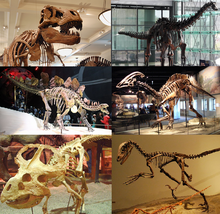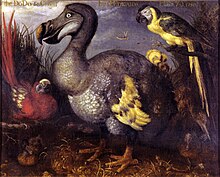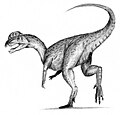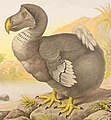Изумирање — разлика између измена
м Категорија |
. |
||
| Ред 1: | Ред 1: | ||
{{short description|Укидање таксона смрћу последњег члана}}{{рут}} |
|||
| ⚫ | '''Изумирање''' или '''екстинкција''' (''-{extinction}-'') је крај постојања одређеног биолошког [[таксон]]а, најчешће [[Врста (биологија)|врсте]]. Одређује се као [[смрт]] последње јединке одређене врсте, мада је сама врста осуђена на изумирање много пре тога. Уколико је изумирање настало дубоко у геолошкој историји [[Земља|Земље]], одређује се време према фосилним белешкама. |
||
[[File:Thylacinus cynocephalus (Gould).jpg|thumb|250п|The Tasmanian tiger (''[[Thylacinus cynocephalus]]'') is an example of an extinct species.]] |
|||
| ⚫ | '''Изумирање''' или '''екстинкција''' (''-{extinction}-'') је крај постојања одређеног биолошког [[таксон]]а, најчешће [[Врста (биологија)|врсте]]. Одређује се као [[смрт]] последње јединке одређене врсте, мада је сама врста осуђена на изумирање много пре тога. Уколико је изумирање настало дубоко у геолошкој историји [[Земља|Земље]], одређује се време према фосилним белешкама. Because a species' potential [[Range (biology)|range]] may be very large, determining this moment is difficult, and is usually done retrospectively. This difficulty leads to phenomena such as [[Lazarus taxon|Lazarus taxa]], where a species presumed extinct abruptly "reappears" (typically in the [[fossil|fossil record]]) after a period of apparent absence. |
||
More than 99% of all species that ever [[Life|lived]] on Earth, amounting to over five billion species,<ref name="Book-Biology">{{cite book |editor1=Kunin, W.E. |editor2=Gaston, Kevin |title=The Biology of Rarity: Causes and consequences of rare–common differences |url=https://books.google.com/books?id=4LHnCAAAQBAJ&pg=PA110 |year=1996 |isbn=978-0412633805 |access-date=26 May 2015 }}</ref> are estimated to have died out.<ref name="Jablonski2004">{{cite journal | title=Extinction: past and present | last=Jablonski | first=D. | journal=Nature | year=2004 | volume=427 | issue=6975 | page=589 | doi=10.1038/427589a| pmid=14961099 | bibcode=2004Natur.427..589J | s2cid=4412106 }}</ref><ref name="StearnsStearns2000">{{cite book |last1=Stearns |first1=Beverly Peterson |last2=Stearns |first2=S.C. |last3=Stearns |first3=Stephen C. |title=Watching, from the Edge of Extinction |url=https://books.google.com/books?id=0BHeC-tXIB4C&q=99%20percent |year=2000 |publisher=[[Yale University Press]] |isbn=978-0-300-08469-6|page=preface x |access-date=30 May 2017 }}</ref><ref name="NYT-20141108-MJN">{{cite news |last=Novacek |first=Michael J. |title=Prehistory's Brilliant Future |url=https://www.nytimes.com/2014/11/09/opinion/sunday/prehistorys-brilliant-future.html |date=8 November 2014 |work=[[The New York Times]] |access-date=2014-12-25 }}</ref><ref name="Newman" /> It is estimated that there are currently around 8.7 million species of [[eukaryote]] globally,<ref name="PLoSbiologyspeciescensus">{{Cite journal | doi=10.1371/journal.pbio.1001127| title=How Many Species Are There on Earth and in the Ocean?| year=2011| last1=Mora| first1=Camilo| last2=Tittensor| first2=Derek P.| last3=Adl| first3=Sina| last4=Simpson| first4=Alastair G. B.| last5=Worm| first5=Boris| journal=PLOS Biology| volume=9| issue=8| pages=e1001127| pmid=21886479| pmc=3160336}}</ref> and possibly many times more if [[microorganism]]s, like bacteria, are included.<ref name="NSF-2016002">{{cite news |author=<!--Staff writer(s); no by-line.--> |title=Researchers find that Earth may be home to 1 trillion species |url=https://www.nsf.gov/news/news_summ.jsp?cntn_id=138446 |date=2 May 2016 |work=[[National Science Foundation]] |access-date=6 May 2016 }}</ref> Notable extinct animal species include [[non-avian dinosaurs]], [[saber-toothed cats]], [[dodos]], [[mammoths]], [[ground sloths]], [[thylacines]], [[trilobites]] and [[golden toads]]. |
|||
Through [[evolution]], species arise through the process of [[speciation]]—where new varieties of organisms arise and thrive when they are able to find and exploit an [[ecological niche]]—and species become extinct when they are no longer able to survive in changing conditions or against superior [[Competition (biology)|competition]]. The relationship between animals and their ecological niches has been firmly established.<ref name="SahneyBentonFerry2010LinksDiversityVertebrates">{{cite journal | last1=Sahney | first1=S. | last2=Benton | first2=M.J. | last3=Ferry | first3=P.A. | year=2010 | title=Links between global taxonomic diversity, ecological diversity and the expansion of vertebrates on land | journal=Biology Letters | doi=10.1098/rsbl.2009.1024 | volume=6 | pages=544–547 | issue=4 | pmid=20106856 | pmc=2936204 }}</ref> A typical species becomes extinct within 10 million years of its first appearance,<ref name="Newman">{{cite journal | last1 = Newman | first1 = Mark | year = 1997 | title = ''A model of mass extinction''| journal = Journal of Theoretical Biology | volume = 189 | issue = 3| pages = 235–252 | doi=10.1006/jtbi.1997.0508| pmid = 9441817 | arxiv = adap-org/9702003| bibcode = 1997JThBi.189..235N | s2cid = 9892809 }}</ref> although some species, called [[living fossil]]s, survive with little to no [[morphology (biology)|morphological]] change for hundreds of millions of years. |
|||
[[Extinction event|Mass extinctions]] are relatively rare events; however, isolated extinctions are quite common. Only recently have extinctions been recorded and scientists have become alarmed at the [[Holocene extinction#Defaunation|current high rate of extinctions]].<ref name="MSNBC">[http://www.nbcnews.com/id/6502368 Species disappearing at an alarming rate, report says]. [[NBC News]]. Retrieved July 26, 2006.</ref><ref>{{YouTube|z9gHuAwxwAs|The Sixth Extinction}} ([[PBS Digital Studios]], November 17, 2014)</ref><ref>{{cite journal | last1 = Ceballos | first1 = Gerardo| last2 = Ehrlich| first2 = Paul R.| last3 = Barnosky| first3= Anthony D.|author-link3=Anthony David Barnosky | last4 = García | first4 = Andrés | last5 = Pringle | first5 = Robert M.| last6 = Palmer| first6 =Todd M. | year = 2015 | title = Accelerated modern human–induced species losses: Entering the sixth mass extinction | journal = [[Science Advances]] | volume = 1 | issue = 5 | page = e1400253 |doi = 10.1126/sciadv.1400253| pmid = 26601195| pmc = 4640606| bibcode = 2015SciA....1E0253C}}</ref><ref>{{cite journal|vauthors=Ripple WJ, Wolf C, Newsome TM, Galetti M, Alamgir M, Crist E, Mahmoud MI, Laurance WF|title=World Scientists' Warning to Humanity: A Second Notice|journal=[[BioScience]]|date=13 November 2017|volume=67|issue=12|pages=1026–1028|doi=10.1093/biosci/bix125|quote=Moreover, we have unleashed a mass extinction event, the sixth in roughly 540 million years, wherein many current life forms could be annihilated or at least committed to extinction by the end of this century.|title-link=World Scientists' Warning to Humanity|doi-access=free}}</ref> Most species that become extinct are never scientifically documented. Some scientists estimate that up to half of presently existing plant and animal species may become extinct by 2100.<ref name="Wilson">[[E.O. Wilson|Wilson, E.O.]], ''The Future of Life'' (2002) ({{ISBN|0-679-76811-4}}). See also: [[Richard Leakey|Leakey, Richard]], ''The Sixth Extinction : Patterns of Life and the Future of Humankind'', {{ISBN|0-385-46809-1}}</ref> A 2018 report indicated that the [[Phylogenetics|phylogenetic diversity]] of 300 mammalian species erased during the human era since the [[Late Pleistocene]] would require 5 to 7 million years to recover.<ref name="davis2018">{{cite journal |pmid=30322924|pmc=6217385|doi=10.1073/pnas.1804906115|journal=Proc Natl Acad Sci U S A|year=2018|volume=115|issue=44|pages=11262–11267|title=Mammal diversity will take millions of years to recover from the current biodiversity crisis|vauthors=Davis M, Faurby S, Svenning JC|doi-access=free}}</ref> |
|||
According to the 2019 ''[[Global Assessment Report on Biodiversity and Ecosystem Services]]'' by [[IPBES]], the biomass of wild mammals has fallen by 82%, natural ecosystems have lost about half their area and a million species are at risk of extinction—all largely as a result of human actions. Twenty-five percent of plant and animal species are [[Threatened species|threatened]] with extinction.<ref>{{cite news |last= Watts|first=Jonathan|date=May 6, 2019 |title=Human society under urgent threat from loss of Earth's natural life|url=https://www.theguardian.com/environment/2019/may/06/human-society-under-urgent-threat-loss-earth-natural-life-un-report|work=[[The Guardian]] |access-date=May 6, 2019 }}</ref><ref name="NYT-20190506">{{cite news |last=Plumer |first=Brad |title=Humans Are Speeding Extinction and Altering the Natural World at an 'Unprecedented' Pace |url=https://www.nytimes.com/2019/05/06/climate/biodiversity-extinction-united-nations.html |date=May 6, 2019 |work=[[The New York Times]] |access-date=May 6, 2019 }}</ref><ref name="IPBES-20190506">{{cite news |author=<!--Staff writer(s); no by-line.--> |title=Media Release: Nature's Dangerous Decline 'Unprecedented'; Species Extinction Rates 'Accelerating' |url=https://www.ipbes.net/news/Media-Release-Global-Assessment |date=May 6, 2019 |work=[[Intergovernmental Science-Policy Platform on Biodiversity and Ecosystem Services]] |access-date=May 6, 2019 }}</ref> |
|||
In June 2019, one million species of plants and animals were at risk of extinction. At least 571 species have been lost since 1750, but likely many more. The main cause of the extinctions is the destruction of natural habitats by human activities, such as cutting down forests and converting land into fields for farming.<ref>{{cite web|url=https://www.theguardian.com/environment/2019/jun/10/frightening-number-of-plant-extinctions-found-in-global-survey|title='Frightening' number of plant extinctions found in global survey|website=The Guardian|date=10 June 2019}}</ref> |
|||
== Дефиниција == |
|||
[[File:LepidodendronOhio.jpg|thumb|right|External mold of the extinct ''[[Lepidodendron]]'' from the [[Upper Carboniferous]] of [[Ohio]]<ref name="Lepidodendron">Davis, Paul and Kenrick, Paul. ''Fossil Plants''. Smithsonian Books, Washington, DC. (2004). Morran, Robin, C. {{ISBN?}}; ''A Natural History of Ferns''. Timber Press (2004). {{ISBN|0-88192-667-1}}</ref>]] |
|||
A species is extinct when the last existing member dies. Extinction therefore becomes a certainty when there are no surviving individuals that can reproduce and create a new generation. A species may become [[functional extinction|functionally extinct]] when only a handful of individuals survive, which cannot reproduce due to poor health, age, sparse distribution over a large range, a lack of individuals of both sexes (in [[sexual reproduction|sexually reproducing]] species), or other reasons. |
|||
Pinpointing the extinction (or [[pseudoextinction]]) of a species requires a [[Theory of species|clear definition of that species]]. If it is to be declared extinct, the species in question must be uniquely distinguishable from any ancestor or daughter species, and from any other closely related species. Extinction of a species (or replacement by a daughter species) plays a key role in the [[punctuated equilibrium]] hypothesis of [[Stephen Jay Gould]] and [[Niles Eldredge]].<ref>See: Niles Eldredge, ''Time Frames: Rethinking of Darwinian Evolution and the Theory of Punctuated Equilibria'', 1986, Heinemann {{ISBN|0-434-22610-6}}</ref> |
|||
[[File:Various dinosaurs.png|thumb|left|Skeleton of various extinct [[dinosaur]]s; some other dinosaur lineages still flourish in the form of [[birds]]]] |
|||
In [[ecology]], ''extinction'' is sometimes used informally to refer to [[local extinction]], in which a species ceases to exist in the chosen area of study, despite still existing elsewhere. Local extinctions may be made good by the reintroduction of individuals of that species taken from other locations; [[wolf reintroduction]] is an example of this. Species that are not globally extinct are termed [[Extant taxon|extant]]. Those species that are extant, yet are threatened with extinction, are referred to as [[threatened]] or [[endangered species]]. |
|||
[[File:Edwards' Dodo.jpg|thumb|The [[dodo]] of [[Mauritius]], shown here in a 1626 illustration by [[Roelant Savery]], is an often-cited example of [[Holocene extinction|modern extinction]].<ref name="Diamond">{{cite book | last = Diamond | first = Jared | author-link = Jared Diamond | title = Guns, Germs, and Steel | publisher = W.W. Norton|year = 1999| isbn = 978-0-393-31755-8 | pages=[https://archive.org/details/gunsgermssteelfa00diam/page/43 43–44] |chapter=Up to the Starting Line | title-link = Guns, Germs, and Steel }}</ref>]] |
|||
Currently, an important aspect of extinction is human attempts to preserve critically endangered species. These are reflected by the creation of the [[conservation status]] [[extinct in the wild|"extinct in the wild" (EW)]]. Species listed under this status by the [[International Union for Conservation of Nature]] (IUCN) are not known to have any living specimens in the wild and are maintained only in [[zoo]]s or other artificial environments. Some of these species are functionally extinct, as they are no longer part of their natural habitat and it is unlikely the species will ever be restored to the wild.<ref name="Maas">Maas, Peter. "[http://www.petermaas.nl/extinct/wilduk.htm Extinct in the Wild" ''The Extinction Website''. URL accessed January 26 2007.] {{webarchive |url=https://web.archive.org/web/20070216030551/http://www.petermaas.nl/extinct/wilduk.htm |date=February 16, 2007 }}</ref> When possible, modern [[zoology|zoological]] institutions try to maintain a [[viable population]] for species preservation and possible future [[reintroduction]] to the wild, through use of carefully planned [[breeding program]]s. |
|||
The extinction of one species' wild population can have knock-on effects, causing further extinctions. These are also called "chains of extinction".<ref>{{cite journal|url=http://theory.ph.man.ac.uk/~ajm/qui05a.pdf|title=Deleting species from model food webs|access-date=2007-02-15|journal=Oikos|last=Quince|first=Christopher|archive-url=https://web.archive.org/web/20060925092540/http://theory.ph.man.ac.uk/~ajm/qui05a.pdf <!-- Bot retrieved archive -->|archive-date=2006-09-25|display-authors=etal|bibcode=2004q.bio.....1037Q|year=2004|arxiv=q-bio/0401037|doi=10.1111/j.0030-1299.2005.13493.x|volume=110|issue=2|pages=283–296|s2cid=16750824}}</ref> This is especially common with extinction of [[keystone species]]. |
|||
A 2018 study indicated that the sixth mass extinction started in the [[Late Pleistocene]] could take up to 5 to 7 million years to restore 2.5 billion years of unique mammal diversity to what it was before the human era.<ref name=davis2018/><ref>{{Cite news|url=https://www.huffingtonpost.com/entry/mammal-diversity-extinction-study_us_5bc59f68e4b055bc94796ecf|title=Mammals Will Still Be Recovering From Human Destruction Long After We're Gone|last=Mosbergen|first=Dominique|date=2018-10-16|work=Huffington Post|access-date=2018-10-16|language=en-US}}</ref> |
|||
== Галерија == |
== Галерија == |
||
| Ред 8: | Ред 38: | ||
Слика:"Benjamin".jpg|Последњи познати примерак [[торбарски вук|тилацина]], изумрлих [[1936]]. године |
Слика:"Benjamin".jpg|Последњи познати примерак [[торбарски вук|тилацина]], изумрлих [[1936]]. године |
||
</gallery> |
</gallery> |
||
== Референце == |
|||
{{Reflist}} |
|||
== Литература == |
== Литература == |
||
| Ред 14: | Ред 47: | ||
== Спољашње везе == |
== Спољашње везе == |
||
{{Категорија на Остави|Extinction}} |
{{Категорија на Остави|Extinction}} |
||
* [http://creo.amnh.org Committee on recently extinct organisms] |
|||
{{клица-биологија}} |
|||
* [https://www.theguardian.com/environment/series/the-age-of-extinction The age of extinction] series in ''[[The Guardian]]'' |
|||
{{Authority control}} |
|||
[[Категорија:Биологија]] |
[[Категорија:Биологија]] |
||
Верзија на датум 6. септембар 2021. у 01:05
Један корисник управо ради на овом чланку. Молимо остале кориснике да му допусте да заврши са радом. Ако имате коментаре и питања у вези са чланком, користите страницу за разговор.
Хвала на стрпљењу. Када радови буду завршени, овај шаблон ће бити уклоњен. Напомене
|

Изумирање или екстинкција (extinction) је крај постојања одређеног биолошког таксона, најчешће врсте. Одређује се као смрт последње јединке одређене врсте, мада је сама врста осуђена на изумирање много пре тога. Уколико је изумирање настало дубоко у геолошкој историји Земље, одређује се време према фосилним белешкама. Because a species' potential range may be very large, determining this moment is difficult, and is usually done retrospectively. This difficulty leads to phenomena such as Lazarus taxa, where a species presumed extinct abruptly "reappears" (typically in the fossil record) after a period of apparent absence.
More than 99% of all species that ever lived on Earth, amounting to over five billion species,[1] are estimated to have died out.[2][3][4][5] It is estimated that there are currently around 8.7 million species of eukaryote globally,[6] and possibly many times more if microorganisms, like bacteria, are included.[7] Notable extinct animal species include non-avian dinosaurs, saber-toothed cats, dodos, mammoths, ground sloths, thylacines, trilobites and golden toads.
Through evolution, species arise through the process of speciation—where new varieties of organisms arise and thrive when they are able to find and exploit an ecological niche—and species become extinct when they are no longer able to survive in changing conditions or against superior competition. The relationship between animals and their ecological niches has been firmly established.[8] A typical species becomes extinct within 10 million years of its first appearance,[5] although some species, called living fossils, survive with little to no morphological change for hundreds of millions of years.
Mass extinctions are relatively rare events; however, isolated extinctions are quite common. Only recently have extinctions been recorded and scientists have become alarmed at the current high rate of extinctions.[9][10][11][12] Most species that become extinct are never scientifically documented. Some scientists estimate that up to half of presently existing plant and animal species may become extinct by 2100.[13] A 2018 report indicated that the phylogenetic diversity of 300 mammalian species erased during the human era since the Late Pleistocene would require 5 to 7 million years to recover.[14]
According to the 2019 Global Assessment Report on Biodiversity and Ecosystem Services by IPBES, the biomass of wild mammals has fallen by 82%, natural ecosystems have lost about half their area and a million species are at risk of extinction—all largely as a result of human actions. Twenty-five percent of plant and animal species are threatened with extinction.[15][16][17]
In June 2019, one million species of plants and animals were at risk of extinction. At least 571 species have been lost since 1750, but likely many more. The main cause of the extinctions is the destruction of natural habitats by human activities, such as cutting down forests and converting land into fields for farming.[18]
Дефиниција

A species is extinct when the last existing member dies. Extinction therefore becomes a certainty when there are no surviving individuals that can reproduce and create a new generation. A species may become functionally extinct when only a handful of individuals survive, which cannot reproduce due to poor health, age, sparse distribution over a large range, a lack of individuals of both sexes (in sexually reproducing species), or other reasons.
Pinpointing the extinction (or pseudoextinction) of a species requires a clear definition of that species. If it is to be declared extinct, the species in question must be uniquely distinguishable from any ancestor or daughter species, and from any other closely related species. Extinction of a species (or replacement by a daughter species) plays a key role in the punctuated equilibrium hypothesis of Stephen Jay Gould and Niles Eldredge.[20]

In ecology, extinction is sometimes used informally to refer to local extinction, in which a species ceases to exist in the chosen area of study, despite still existing elsewhere. Local extinctions may be made good by the reintroduction of individuals of that species taken from other locations; wolf reintroduction is an example of this. Species that are not globally extinct are termed extant. Those species that are extant, yet are threatened with extinction, are referred to as threatened or endangered species.

Currently, an important aspect of extinction is human attempts to preserve critically endangered species. These are reflected by the creation of the conservation status "extinct in the wild" (EW). Species listed under this status by the International Union for Conservation of Nature (IUCN) are not known to have any living specimens in the wild and are maintained only in zoos or other artificial environments. Some of these species are functionally extinct, as they are no longer part of their natural habitat and it is unlikely the species will ever be restored to the wild.[22] When possible, modern zoological institutions try to maintain a viable population for species preservation and possible future reintroduction to the wild, through use of carefully planned breeding programs.
The extinction of one species' wild population can have knock-on effects, causing further extinctions. These are also called "chains of extinction".[23] This is especially common with extinction of keystone species.
A 2018 study indicated that the sixth mass extinction started in the Late Pleistocene could take up to 5 to 7 million years to restore 2.5 billion years of unique mammal diversity to what it was before the human era.[14][24]
Галерија
-
Фосилни остатак трилобита, изумрлих пре 250 милиона година
-
Диплохосаурус, један од многих изумрлих диносаура
Референце
- ^ Kunin, W.E.; Gaston, Kevin, ур. (1996). The Biology of Rarity: Causes and consequences of rare–common differences. ISBN 978-0412633805. Приступљено 26. 5. 2015.
- ^ Jablonski, D. (2004). „Extinction: past and present”. Nature. 427 (6975): 589. Bibcode:2004Natur.427..589J. PMID 14961099. S2CID 4412106. doi:10.1038/427589a.
- ^ Stearns, Beverly Peterson; Stearns, S.C.; Stearns, Stephen C. (2000). Watching, from the Edge of Extinction. Yale University Press. стр. preface x. ISBN 978-0-300-08469-6. Приступљено 30. 5. 2017.
- ^ Novacek, Michael J. (8. 11. 2014). „Prehistory's Brilliant Future”. The New York Times. Приступљено 2014-12-25.
- ^ а б Newman, Mark (1997). „A model of mass extinction”. Journal of Theoretical Biology. 189 (3): 235—252. Bibcode:1997JThBi.189..235N. PMID 9441817. S2CID 9892809. arXiv:adap-org/9702003
 . doi:10.1006/jtbi.1997.0508.
. doi:10.1006/jtbi.1997.0508.
- ^ Mora, Camilo; Tittensor, Derek P.; Adl, Sina; Simpson, Alastair G. B.; Worm, Boris (2011). „How Many Species Are There on Earth and in the Ocean?”. PLOS Biology. 9 (8): e1001127. PMC 3160336
 . PMID 21886479. doi:10.1371/journal.pbio.1001127.
. PMID 21886479. doi:10.1371/journal.pbio.1001127.
- ^ „Researchers find that Earth may be home to 1 trillion species”. National Science Foundation. 2. 5. 2016. Приступљено 6. 5. 2016.
- ^ Sahney, S.; Benton, M.J.; Ferry, P.A. (2010). „Links between global taxonomic diversity, ecological diversity and the expansion of vertebrates on land”. Biology Letters. 6 (4): 544—547. PMC 2936204
 . PMID 20106856. doi:10.1098/rsbl.2009.1024.
. PMID 20106856. doi:10.1098/rsbl.2009.1024.
- ^ Species disappearing at an alarming rate, report says. NBC News. Retrieved July 26, 2006.
- ^ The Sixth Extinction на сајту YouTube (PBS Digital Studios, November 17, 2014)
- ^ Ceballos, Gerardo; Ehrlich, Paul R.; Barnosky, Anthony D.; García, Andrés; Pringle, Robert M.; Palmer, Todd M. (2015). „Accelerated modern human–induced species losses: Entering the sixth mass extinction”. Science Advances. 1 (5): e1400253. Bibcode:2015SciA....1E0253C. PMC 4640606
 . PMID 26601195. doi:10.1126/sciadv.1400253.
. PMID 26601195. doi:10.1126/sciadv.1400253.
- ^ Ripple WJ, Wolf C, Newsome TM, Galetti M, Alamgir M, Crist E, Mahmoud MI, Laurance WF (13. 11. 2017). „World Scientists' Warning to Humanity: A Second Notice”. BioScience. 67 (12): 1026—1028. doi:10.1093/biosci/bix125
 . „Moreover, we have unleashed a mass extinction event, the sixth in roughly 540 million years, wherein many current life forms could be annihilated or at least committed to extinction by the end of this century.”
. „Moreover, we have unleashed a mass extinction event, the sixth in roughly 540 million years, wherein many current life forms could be annihilated or at least committed to extinction by the end of this century.”
- ^ Wilson, E.O., The Future of Life (2002) (ISBN 0-679-76811-4). See also: Leakey, Richard, The Sixth Extinction : Patterns of Life and the Future of Humankind, ISBN 0-385-46809-1
- ^ а б Davis M, Faurby S, Svenning JC (2018). „Mammal diversity will take millions of years to recover from the current biodiversity crisis”. Proc Natl Acad Sci U S A. 115 (44): 11262—11267. PMC 6217385
 . PMID 30322924. doi:10.1073/pnas.1804906115
. PMID 30322924. doi:10.1073/pnas.1804906115  .
.
- ^ Watts, Jonathan (6. 5. 2019). „Human society under urgent threat from loss of Earth's natural life”. The Guardian. Приступљено 6. 5. 2019.
- ^ Plumer, Brad (6. 5. 2019). „Humans Are Speeding Extinction and Altering the Natural World at an 'Unprecedented' Pace”. The New York Times. Приступљено 6. 5. 2019.
- ^ „Media Release: Nature's Dangerous Decline 'Unprecedented'; Species Extinction Rates 'Accelerating'”. Intergovernmental Science-Policy Platform on Biodiversity and Ecosystem Services. 6. 5. 2019. Приступљено 6. 5. 2019.
- ^ „'Frightening' number of plant extinctions found in global survey”. The Guardian. 10. 6. 2019.
- ^ Davis, Paul and Kenrick, Paul. Fossil Plants. Smithsonian Books, Washington, DC. (2004). Morran, Robin, C. [недостаје ISBN]; A Natural History of Ferns. Timber Press (2004). ISBN 0-88192-667-1
- ^ See: Niles Eldredge, Time Frames: Rethinking of Darwinian Evolution and the Theory of Punctuated Equilibria, 1986, Heinemann ISBN 0-434-22610-6
- ^ Diamond, Jared (1999). „Up to the Starting Line”. Guns, Germs, and Steel. W.W. Norton. стр. 43–44. ISBN 978-0-393-31755-8.
- ^ Maas, Peter. "Extinct in the Wild" The Extinction Website. URL accessed January 26 2007. Архивирано фебруар 16, 2007 на сајту Wayback Machine
- ^ Quince, Christopher; et al. (2004). „Deleting species from model food webs” (PDF). Oikos. 110 (2): 283—296. Bibcode:2004q.bio.....1037Q. S2CID 16750824. arXiv:q-bio/0401037
 . doi:10.1111/j.0030-1299.2005.13493.x. Архивирано из оригинала (PDF) 2006-09-25. г. Приступљено 2007-02-15.
. doi:10.1111/j.0030-1299.2005.13493.x. Архивирано из оригинала (PDF) 2006-09-25. г. Приступљено 2007-02-15.
- ^ Mosbergen, Dominique (2018-10-16). „Mammals Will Still Be Recovering From Human Destruction Long After We're Gone”. Huffington Post (на језику: енглески). Приступљено 2018-10-16.
Литература
- Рауп, Дејвид (2015). Изумирање - лоши гени или лоша срећа. Смедерево: Хеликс. ISBN 978-86-86059-62-8.




